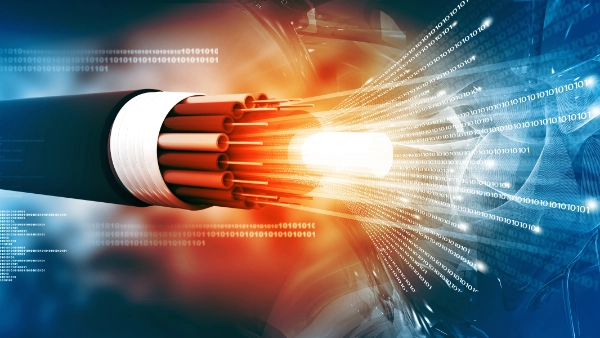Fast data highways thanks to quartz glass
Fast Internet for all of Germany? By 2025, every household should be connected to fast networks - this is the promise of the German government. Telecommunications providers are therefore massively pushing broadband expansion and replacing copper cable with fiber optics. In other countries, the demand for fast networks is just as great; after all, fiber optics are essential for the digitization of entire branches of industry. But for providers to be able to expand networks worldwide, they need a lot of quartz glass.

Networks are being upgraded worldwide and several million kilometers of fiber optic cable are laid every year. In Germany, eleven percent of all households can currently access fiber optic internet with their own modem. The goal of the German government: By 2025, all of Germany is to be supplied via fast networks. However, this also includes DSL and TV cable connections with a higher bandwidth, which still rely on copper lines for the last mile. Other countries are already further ahead in terms of fiber optic expansion: In Europe, Iceland, Belarus, Sweden, Spain and Latvia lead the way with a coverage of over 50 percent. In China and South Korea, as much as around 80 percent of all broadband connections are realized via fiber optics (as of 2019). But what is fiber optic actually and why is the technology so much better than copper cable?
Optical fibers are hair-thin and made of glass that is coated with plastic to stabilize it. It transmits the data of Internet communication by means of light. Because light in glass is less susceptible to interference than an electrical signal in a copper cable, much more data can be transmitted via a fiber optic cable. Most recently, British researchers sent 178 terabits of data per second through a fiber optic cable. According to Heraeus calculations, this means that all the film and television programs that a person watches in their lifetime can be transmitted in just a few seconds. Today's standard for long-distance traffic is already over 30 terabits. Furthermore, much less energy is lost in fiber optics than in copper cable, and it is weather-resistant, incombustible and therefore suitable for the expansion of the broadband network.
Quartz glass cylinder as basis for fiber optic expansion
Even though the optical fiber is very thin, the millions of kilometers of cable each year require around 15 thousand tons of quartz glass. About a quarter of this comes from Heraeus Comvance in Bitterfeld. More than 10,000 cylinders are produced there annually from synthetic and thus particularly pure and stable quartz glass. A single cylinder has a diameter of up to 23 centimeters, weighs up to over 200 kilograms, and then produces around 10,000 kilometers of optical fiber. Increasing internet traffic raises the need for optical fibers and at the same time, the demands on the individual fiber are also increasing. That is why Heraeus Comvance is working with partners to develop the fibers of the future. These include fibers with particularly low losses for long-distance traffic, fibers with multiple cores for large data centers such as those used by Google or Microsoft, and fibers with a hollow core for applications that require low latencies, such as autonomous driving or remote control of medical interventions.
After mechanical processing, Heraeus Comvance delivers the cylinders to fiber optic manufacturers worldwide – from China and the USA to India. This enables countries to drive the expansion of their broadband networks and provide high-speed internet to rural regions.

